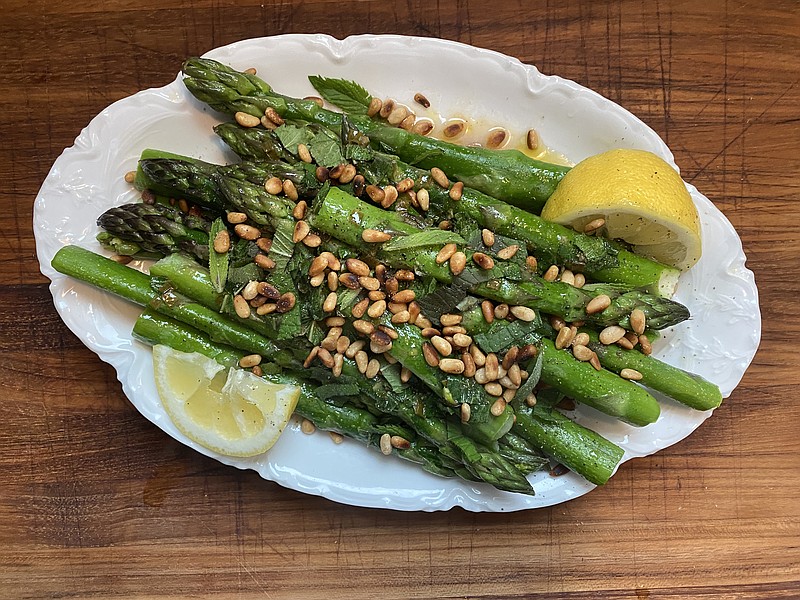For a long time, cooking asparagus any way other than the very simplest seemed like gilding the spear to me. Blanching it in boiling water for just a few minutes until just tender and bright green like a spring dream, then eating it as soon as possible – what could be better than this?
My grandmother, who raised Angus cattle in Sunnyside, Wash., out east of the mountains past Yakima, made it this way. To be honest, she generally let it cook too long, but it still was excellent. Asparagus was often the crop in the field adjoining her modest spread, which meant that when the season came, the good stuff was literal steps and moments from quiet early-evening field to happy family plate. Under these circumstances, asparagus prepared with the least intervention possible is difficult to best.
At home in Seattle, my dad eventually started grilling it – just asparagus, olive oil, salt and pepper, turned once or twice until roasty-tender – also great, especially with a steak from a cow Grandma had raised. Then, as I started writing about restaurants in the city, I'd eat local asparagus anywhere it appeared on a menu during the short but sweet Washington season – springtime from sometime in April through most of June, weather depending. More elaborate preparations were almost always hugely disappointing. One notable exception: the asparagus with chèvre vinaigrette, green onions and toasted pine nuts served annually at Le Pichet, as well as, back then, at Cafe Presse (R.I.P.).
The following recipe lets you choose your own buttery asparagus adventure. What does your taste tell you about what would go well with it, in terms of allium and fresh herbs? Or what you happen to have on hand, on the windowsill or in the garden?
The customizable approach here came about by way of messing around with a New York Times recipe for Butter-Braised Asparagus by David Tanis – his involves chives, parsley or chervil, tarragon and optional dill. But the chives can be substituted at will with shallot, green onion, spring onion, ramps or leeks; garlic seems too forceful in this application to me, but hey, do what you feel.
I felt mint might be a friend to asparagus, and it turns out that the fresh, cooling, lightly spicy-sweetness also plays nicely with peppery springtime chives. Dill, as Tanis recommends, wouldn't be to my taste with asparagus, but try any and all fresh soft herbs that sound good to you. These are just guidelines to get to the asparagus that'll be your favorite, not mine, with or without a sprinkling of toasted pine nuts.
If you find yourself lemon-less, pretty much any kind of vinegar is a good substitute, though I'd reduce it to 1 ½ tablespoons and perhaps avoid the distinct taste of balsamic.
Buttery Braised Asparagus
With Your Perfect Choice of Fresh Herb(s)
- 1 ½ pounds asparagus
- 6 tablespoons salted butter
- Kosher salt and fresh-ground pepper
- 1 tablespoon snipped fresh chives -- or use your allium of choice, such as green onion, spring onion, ramps, shallot
- 2 tablespoons lemon juice
- ½ teaspoon lemon zest
- 3 tablespoons chopped mint, parsley, tarragon, marjoram, chervil and/or dill (but maybe not, you know, cilantro)
- 1 to 2 tablespoons pine nuts, toasted until nicely browned, optional
Rinse the asparagus spears in cool water, and snap off the tough ends – bend them toward the bottom, and they'll break at the right spot. (You can save them for making asparagus soup.)
Put the butter in a large skillet, and turn heat to medium-high. When butter is melted, add asparagus, then sprinkle with salt and pepper. Add ½ cup water, cover and simmer. Check it right at 3 minutes: You want your spears bright green, quite firm but getting tender, and they will keep cooking a little once the heat is off. Shift them around, and cook another minute or two as needed for fatter spears. Move the asparagus to a serving platter, reserving the stuff in the pan.
Turn the heat to high; add the chives; cook, stirring, until most of the liquid has evaporated and you get a saucy consistency. Add lemon juice and zest, turn off heat and stir in most of your fresh herb(s), saving a bit for garnishing. Taste and add salt and/or pepper, and/or a squeeze of lemon, to your liking. Pour the sauce over the asparagus, sprinkle with extra herb(s) and the pine nuts, if you've got them, and enjoy.
Makes 2 to 4 servings, depending on asparagus appetite.

